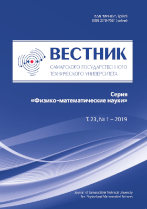|
Mathematical Modeling, Numerical Methods and Software Complexes
Mathematical modeling of the asteroids' motion belonging to the Apollo and Aten groups
A. F. Zausaev, M. A. Romanyuk, A. A. Zausaev
Samara State Technical University, Samara, 443100, Russian Federation
(published under the terms of the Creative Commons Attribution 4.0 International License)
Abstract:
This article evaluates the accuracy of solutions to differential equations of motion, taking into account relativistic effects obtained on the basis of a new principle of interaction, using the example of studies of the evolution of the orbits of five asteroids.
A numerical integration of equations of the asteroids' motion with the initial data referred to different points in time is carried out. Based on a comparison of the results of the study, certain patterns are revealed. At time intervals in the absence of rapprochement of the asteroid with the Earth less than 0.1 au it is possible to apply with equal efficiency the differential equations given in the paper. The loss of accuracy of numerical integration is directly dependent on the magnitude of the rapprochement of the asteroid width the Earth. Due to the fact that in the right sides of the equations of motion we have differences of the coordinates of the asteroid and the planet, with sufficient proximity, the relative accuracy of the coordinates is many times greater than the relative accuracy of the difference. For the studied asteroids, when they approach the Earth, the relative error of the difference in the coordinates of the asteroid and the Earth is approximately 227 to 44900 times higher than the limiting relative error of the coordinates of the asteroid itself. Predicting the motion of Apophis after its close approach to the Earth based on the solution of the equations of motion by modern methods leads to large errors, the reduction of which is possible only by improving the initial data of the elements of the orbits of the asteroid. About the possibility of close approach of Apophis with the Earth on a time interval from April 14, 2029 to January 1, 2100 it can be argued with a certain degree of probability. The results of the research can be generalized to all asteroids of Apollo and Aten groups.
Keywords:
numerical integration, differential motion equations, asteroids, (99942) Apofis, (367943) Duende, 2012 UE$_{34}$, 1999 AN$_{10}$, 2001 WN$_5$.
Received: April 6, 2020
Revised: November 3, 2020
Accepted: November 16, 2020
First online: December 18, 2020
Citation:
A. F. Zausaev, M. A. Romanyuk, A. A. Zausaev, “Mathematical modeling of the asteroids' motion belonging to the Apollo and Aten groups”, Vestn. Samar. Gos. Tekhn. Univ., Ser. Fiz.-Mat. Nauki [J. Samara State Tech. Univ., Ser. Phys. Math. Sci.], 24:4 (2020), 692–717
Linking options:
https://www.mathnet.ru/eng/vsgtu1779 https://www.mathnet.ru/eng/vsgtu/v224/i4/p692
|

| Statistics & downloads: |
| Abstract page: | 283 | | Full-text PDF : | 210 | | References: | 38 |
|




 Contact us:
Contact us: Terms of Use
Terms of Use
 Registration to the website
Registration to the website Logotypes
Logotypes









 Citation in format
Citation in format 